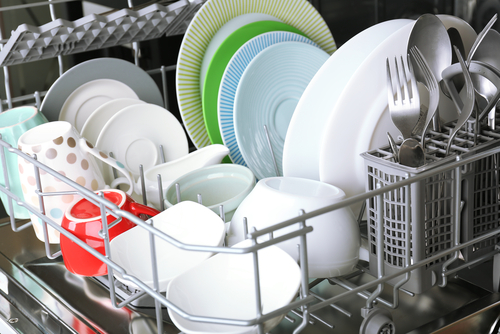Fill Dishwasher
Did you know you can save up to 5,000 gallons of water a year by running your dishwasher only when it’s full and not pre-rinsing? In the great debate over which saves more water—hand washing or using a dishwasher—the dishwasher wins! However, not just any dishwasher load gets the prize. The clear winner goes to an Energy Star dishwasher that is fully loaded with dishes that are not pre-rinsed - using only 3-5 gallons of water. Follow a few basic steps to save precious water resources and money!
Your Impact
Action Steps & Tips
Introduction

In the great debate over which saves more water—hand washing or using a dishwasher—the dishwasher wins! However, not just any dishwasher load gets the prize. The clear winner goes to a full load of dishes that are not pre-rinsed and washed in an Energy Star dishwasher, which uses around 3-5 gallons of water.
In second place is hand washing dishes using a basin filled with soapy water for washing, and another basin filled with clean water for rinsing—not running the water while washing. If you also have a water saving aerator installed on the kitchen faucet, this uses about 8 gallons of water.
Using an older, non-Energy Star dishwasher uses up to 15 gallons or more and regular hand washing (with the water running) uses up to 27 gallons of water!
Running your dishwasher on full and avoiding pre-rinsing:
-
Save time
-
Save energy, water, money and precious water resources
1 Tips to be dishwasher smart
Dishwashers can save up to 5,000 gallons of water a year over handwashing if you follow a few tips:
Run on full. To get the most out of your dishwasher, fill it to full capacity before pressing start. Whether your dishwasher is new or old, running it full is the best way to save water, energy and money.
Avoid pre-rinsing. Rinsing the dishes ahead of time can use 2-5 gallons of water per minute! The good news is that pre-rinsing isn't necessary most of the time. Modern dishwashers have sensors that “measure” how dirty the dishes are before washing and adjust settings accordingly. If you don't have this feature, you might have a manual setting to adjust the amount of cleaning. Scrape food off plates and utensils before loading into the dishwasher.
Check your instruction manual to see what is recommended for your dishwasher. If you need to rinse your dishes before washing, use cold water instead of hot and use the minimum you need to get them ready for the dishwasher.
Wash non-kitchen items. Instead of handwashing items like children’s toys, Ziploc bags, or even sunglasses, save water by throwing them in the dishwasher! A few other items you can throw in include plastic hair brushes, soap dishes, toothbrush holders, sponges and dish brushes, vases, pet toys and food bowls, golf balls, flip flops or unlined rubber boots, microwave trays, refrigerator shelves, washable kitchen exhaust fan filters and more.
In general, small plastic, ceramic, glass or metal items wash great, but don’t put it in if it’s made of wood, cast iron, copper or other material that will not weather the dishwasher well. If you’re not sure, check the manufacturer’s label. If it is greasy or particularly dirty, run the items in a separate load without dishes.
Post a note. Dishwashing is often a family affair, with everyone in the household pitching in. Share this information with others in your household, then put a note on the dishwasher or fridge with tips to remind everyone!
Extra credit : Upgrade an older dishwasher. If your dishwasher is over 10 years old and particularly if it is pre-1994, replacing it can save significantly on both water and energy! Check out the Upgrade Dishwasher action to learn more.


